History

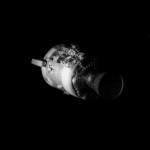 On this the 50th anniversary of the Apollo 13 near disaster, I am reminded of the tenacity of the human spirit. The space program was becoming commonplace, and while the plan was to televise parts of the mission, the networks decided not to play the program, because space travel had become mundane…nothing new happened, and it was then, as it is now, that sensationalism sells news. Then, completely unexpectedly, everything changed. Our astronauts were in serious trouble. After the explosion that would render the space capsule useless, and those famous words were uttered, “Houston, we’ve had a problem here,” everyone wanted to follow this very serious situation. Now it was important to watch this previously mundane mission.
On this the 50th anniversary of the Apollo 13 near disaster, I am reminded of the tenacity of the human spirit. The space program was becoming commonplace, and while the plan was to televise parts of the mission, the networks decided not to play the program, because space travel had become mundane…nothing new happened, and it was then, as it is now, that sensationalism sells news. Then, completely unexpectedly, everything changed. Our astronauts were in serious trouble. After the explosion that would render the space capsule useless, and those famous words were uttered, “Houston, we’ve had a problem here,” everyone wanted to follow this very serious situation. Now it was important to watch this previously mundane mission.
The reactions, both before and after the explosion, are completely normal. People tend to look for the excitement is life to keep them interested…good or bad excitement. We find ourselves glued to the television after a disaster, hoping to learn something new. We are the same way about exciting good news, but with the Apollo 13 mission, the news of another lunar landing wasn’t new. We had seen it all before…until it all went wrong. The NASA families, and especially the families of the astronauts in trouble, were less than impressed by the sudden interest in their men onboard Apollo 13, and I can understand why. It seemed no one cared, until it went wrong. Yes, the people wanted the men home safely, but it was the drama that drew them to the situation, and finally, had us thinking about something outside of ourselves. Yes, all turned out great in the end, and the men came home safely, but the space program didn’t increase in importance in our lives…until the next disaster, that is.
It’s not that we, the people are not interested in anything that doesn’t keep us riveted to our chair, staring at the news, but that we tend to overlook much of what is going on around us, until it affects us. Take the Coronavirus for example. Diseases come and go, and provided it doesn’t impact us or the ones we love, most diseases come and go with little notice by the general public. That’s why pandemics are so widely televised and watched. The affect everyone, in one way or another. We might know someone who has it, or have people in the disease hotspots, or have someone working in healthcare who is dealing with it, or we might just find ourselves drawn to the situation because we are one nation living in one world. Whatever our reason, suddenly we are interested, and that’s when we step outside of ourselves.
I have been very moved by the response of the American people during the Coronavirus Pandemic. We have seen people making medical masks for the hospitals, collecting food for those in need, and going to the store for those who can’t. We have seen people cheering the first responders, healthcare workers, grocery store workers, and food workers, who have all stayed on the job, to keep things running smoothly. We have other businesses that have had to stay open too…the banks, insurance agencies, sanitation workers, street workers, agriculture workers, military and national guard members, and a number of others. All these people are heroes. We could not stay at home, like we have been asked to do, if these heroes didn’t get up and go to work every  day, despite personal risks. As President Trump has said, we are at war…fighting an invisible enemy, so anyone who leaves their house takes a certain measure of risk of contracting the disease. Those who go to work are the bravest people we have. We owe them so much. We have also seen many people who have changed up their entertainment mediums, and have started giving free concerts on the internet. Churches have started streaming services. Choirs from many other areas have put together “social distancing” performances. All these things are designed to keep our spirits up…something we all need in these trying times. The thing that I find the most amazing is how we have all came together, how we stepped outside of ourselves to make a difference.
day, despite personal risks. As President Trump has said, we are at war…fighting an invisible enemy, so anyone who leaves their house takes a certain measure of risk of contracting the disease. Those who go to work are the bravest people we have. We owe them so much. We have also seen many people who have changed up their entertainment mediums, and have started giving free concerts on the internet. Churches have started streaming services. Choirs from many other areas have put together “social distancing” performances. All these things are designed to keep our spirits up…something we all need in these trying times. The thing that I find the most amazing is how we have all came together, how we stepped outside of ourselves to make a difference.
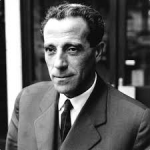
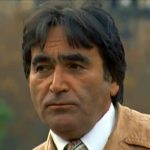 As Hitler’s vicious plan to wipe out the Jewish people started to come together, many Jewish people found their lives ripped away from them, and then, found themselves in the ghettos…if they were lucky, or the “work” camps…if they weren’t. Eventually the plan was to move all the Jews to the camps, or to transport them into the woods and shoot them. Once people were moved into the camp, there was pretty much one way out of there…death. The people dreamed of escaping the camps, but it was futile…until April 10, 1944.
As Hitler’s vicious plan to wipe out the Jewish people started to come together, many Jewish people found their lives ripped away from them, and then, found themselves in the ghettos…if they were lucky, or the “work” camps…if they weren’t. Eventually the plan was to move all the Jews to the camps, or to transport them into the woods and shoot them. Once people were moved into the camp, there was pretty much one way out of there…death. The people dreamed of escaping the camps, but it was futile…until April 10, 1944.
Rudolf Vrba and Alfred Wetzler came from the same hometown of Trnava in Slovakia. Being from the same town, they knew they could trust each other. The two men were determined to escape from Auschwitz so they could somehow let the rest of the world know what was going on there. Every day, they probed Auschwitz for weaknesses. While they searched, they were formulating escape plans. Day after day they rejected plans that they knew would only get them killed, and spoil their chances of completing their mission to save their people. Finally, one day, Fred Wetzler approached Rudi Vrba with a plan that seemed plausible. For the first time, they felt like they had a chance to succeed.
Fred told Rudolf about a pile of wooden planks stacked outside the camp perimeter waiting to be used for construction of a new facility. Fred said he knew of four prisoners planning to hide in a cavity in the middle of the wood pile. The plan was to wait for the SS guards to conclude a mandatory three-day search, and then make their escape and head south toward Slovakia. It was risky, but a few days later the plan went off without a hitch…at least the escape did. The initial strategy planned by the four prisoners, of hiding in the wood planks had worked, and they got away, but a few days later the four prisoners were caught in the village south of the camp. Rudi and Fred were worried that the four prisoners would reveal the method of their escape to the SS, but to their credit, they kept silent.
The secret of the cavity in the stack of planks stayed a secret, and a couple of weeks later, Fred and Rudi decided to attempt the same escape plan themselves. Their escape was far more successful than the escape of the first four prisoners. Once they were out of Auschwitz, Fred and Rudi had roughly 80 miles of Nazi occupied Poland ahead of them before the reached Slovakia. Their journey wasn’t a straightforward trip. They got lost and wandered around a village called Bielsko. It took them all night to find their way out and then in broad daylight, they had no choice to ask for help. They knocked on the door of a house and a woman, knowing that they were on the run, let them in and fed them. Then later that night, she gave them money, and told them how to escape through the mountains.
Of course, their journey was not without it troubles. At one point, they crossed paths with a German patrol. A gun shot sent them scrambling for cover. They heard dogs howling, and as they were running they came upon a stream. It would save them in the end. The water hid their scent, and while the water was freezing, they crossed the stream, and escaped. More strangers helped them along their journey, and against all odds, the two men made it to the Polish-Slovak borer.
On April 21st, 1944, fourteen days after they emerged from the stack of planks, Rudi Vrba and Fred Wetzler reached Slovak soil. Once inside Slovakia, they met yet another sympathetic peasant who brought them to a prominent doctor in the town of Cadca. The doctor listened to their story and said, “Tomorrow I’ll take you to the leaders of the Jewish community in Zilina. They’ll know what’s best to do.” For the rest of his life, Rudolf Vrba, who had escaped from Auschwitz determined to warn the world about the death factory before another train load of Jews could be shipped there, wished the doctor had been right.
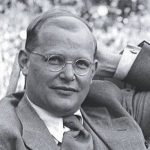 I think we have all thought that the German people were in agreement with the Nazis, but there were, in fact, many German people who fought hard for the other side. One such person who was active in the German resistance was Dietrich Bonhoeffer, who was a Protestant Lutheran Pastor and theologian. He hated Nazism and Hitler’s horrific ideas, and his strong hatred of these things brought him to a place of knowing that he had to do something…anything to stop the murderous regime.
I think we have all thought that the German people were in agreement with the Nazis, but there were, in fact, many German people who fought hard for the other side. One such person who was active in the German resistance was Dietrich Bonhoeffer, who was a Protestant Lutheran Pastor and theologian. He hated Nazism and Hitler’s horrific ideas, and his strong hatred of these things brought him to a place of knowing that he had to do something…anything to stop the murderous regime.
Bonhoeffer was born February 4, 1906 in Breslau, Germany. His family were not religious, but had a strong musical and artistic background. From his childhood days, Bonhoeffer displayed great musical talent, and the pursuit of music was important to him throughout his life. As he grew, I’m sure his family had great plans for his musical future…hoping for him to be a famous musician. When Bonhoeffer turned 14, he announced that he wanted to train and become a priest…a revelation that completely shocked his family.
Despite their displeasure at his announcement, Bonhoeffer attended the University of Berlin, graduating in 1927 with a doctorate in theology for his influential thesis, Sanctorum Communio, which means Communion of Saints. After his graduation, Bonhoeffer spent time in Spain and America. This was likely a good thing, because it gave him a wider outlook on life and helped him move from academic study to a more practical interpretation of the Gospels. He became quite interested in the concept of the Church’s involvement in social justice and protection of those who were oppressed. His wide travels also encouraged a greater interest in ecumenism, which is the outreach to other churches.
At the age of 25, Bonhoeffer was ordained as a priest. Because the early 30’s were a period of great upheaval in Germany, with the instability of Weimar Germany and the mass unemployment of the Great Depression leading to the election of Adolf Hitler in 1933. Hitler was elected as Chancellor in January 1933. He was very charismatic, and therefore, widely welcomed by most of the German people, including large parts of the church, but Bonhoeffer saw through the façade, and remained a firm opponent of Hitler’s philosophy.
Two days after Hitler’s election as Chancellor in Jan 1933, Bonhoeffer made a radio broadcast criticizing Hitler, and in particular the dangers of the idolatrous cult of the Fuhrer. The radio broadcast was almost immediately cut off. Apparently, Hitler already had a large amount of control of the information people received. Being an opponent of Hitler in those days was not looked upon favorably, and unfortunately, they did not have the freedom of speech that we enjoy in the United States.
Many people and even churches were fooled by Hitler, and before they realized it, they had lost the right to do anything about it. Bonhoeffer tried to organize the Protestant Church to reject the Nazi ideology, but they did not listen so he had to breakaway from the church where he was ordained. In April 1933, The Confessing Church which Bonhoeffer helped form with Martin Niemoller, was born. The Confessing Church sought to stand in contrast to the Nazi-supported, German Christian movement. Bonhoeffer felt disillusioned by the weakness of the church and opposition, and in the autumn of 1933, he took a two-year appointment to a German-speaking Protestant church in London.
After two years in London, Bonhoeffer returned to Berlin. He felt like he should be with his native country and  share in its struggles, even if it looked like there was no hope. Shortly after his return, one leader of the Confessing Church was arrested and another fled to Switzerland. Bonhoeffer’s authorization to teach revoked in 1936. He could not teach after being denounced as a pacifist and enemy of the state. Things grew steadily worse, and finally, because of his opposition to the Nazi regime, Bonhoeffer was arrested. He was “sentenced” to death and on April 9, 1945, was executed at the Flossian concentration camp. It was the last month of the war. He had almost survived. He remains an important symbol of opposition to Hitler, and his views on Christianity continue to be influential.
share in its struggles, even if it looked like there was no hope. Shortly after his return, one leader of the Confessing Church was arrested and another fled to Switzerland. Bonhoeffer’s authorization to teach revoked in 1936. He could not teach after being denounced as a pacifist and enemy of the state. Things grew steadily worse, and finally, because of his opposition to the Nazi regime, Bonhoeffer was arrested. He was “sentenced” to death and on April 9, 1945, was executed at the Flossian concentration camp. It was the last month of the war. He had almost survived. He remains an important symbol of opposition to Hitler, and his views on Christianity continue to be influential.
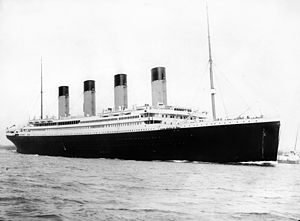 Some historic events seem to continue to intrigue us, many years after the event took place. The RMS Titanic was one of those events. The Titanic sank on its maiden voyage on April 15, 1912…as we all know, considering the movies that have been made detailing and even romanticizing the tragedy. Of course, the way that so many people lost their lives that night is something that many people have wondered about all these years. Musicians who played well into the disaster, in an effort to keep people calm, the many men who died because they did the honorable thing and allowed the women and children to be saved first, and the women who would not leave without their husbands…all of these gave us a glimpse of a time when people did the right thing no matter the cost.
Some historic events seem to continue to intrigue us, many years after the event took place. The RMS Titanic was one of those events. The Titanic sank on its maiden voyage on April 15, 1912…as we all know, considering the movies that have been made detailing and even romanticizing the tragedy. Of course, the way that so many people lost their lives that night is something that many people have wondered about all these years. Musicians who played well into the disaster, in an effort to keep people calm, the many men who died because they did the honorable thing and allowed the women and children to be saved first, and the women who would not leave without their husbands…all of these gave us a glimpse of a time when people did the right thing no matter the cost. 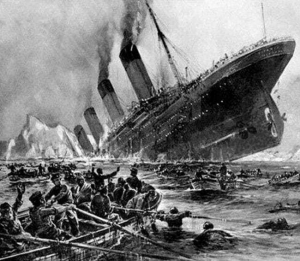 There are precious few of those kinds of people around these days.
There are precious few of those kinds of people around these days.
With all the interest concerning the Titanic, an idea occurred to someone, that maybe there should be a duplicate Titanic…a way to return her to her former glory, even if it is only a duplicate. The new ship is supposed to be an identical copy of the infamous ocean liner, which sank in 1912 following a collision with an iceberg. However, to avoid a repeat disaster, Titanic II will be outfitted with plenty of life boats, and will have a welded, not riveted hull, plus modern navigation and radar equipment.
The project initiated by Australian businessman and politician Clive Palmer, has not always been smooth sailing, 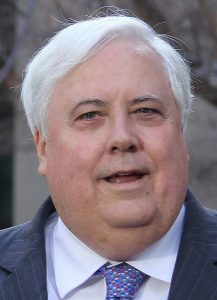 however. The project was announced in April 2012, which was 100 years after the original Titanic sank. The plan was that Titanic II would be the flagship of the proposed cruise company Blue Star Line of Brisbane, Australia. At that time, they intended to launch the Titanic II in 2016. The project was delayed until 2018, and then to an expected 2022 date, but with the 2020 Coronavirus worldwide shutdown, I wonder if that date will also have to be moved back.
however. The project was announced in April 2012, which was 100 years after the original Titanic sank. The plan was that Titanic II would be the flagship of the proposed cruise company Blue Star Line of Brisbane, Australia. At that time, they intended to launch the Titanic II in 2016. The project was delayed until 2018, and then to an expected 2022 date, but with the 2020 Coronavirus worldwide shutdown, I wonder if that date will also have to be moved back.
“The ship will follow the original journey, carrying passengers from Southampton to New York, but she will also circumnavigate the globe, inspiring and enchanting people while attracting unrivaled attention, intrigue and mystery in every port she visits,” said Palmer in a statement. The planned maiden voyage will take passengers from Dubai to New York, however, reports CruiseArabia, with the first sailing scheduled to take place in 2022. It’s possible for this maiden voyage to happen, but it will take a few less problems going forward.
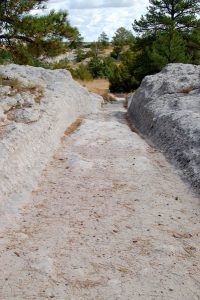 In the years when my kids were in elementary school, every kid in probably 4th or 5th grade got to take a field trip to Guernsey, Wyoming to see the Oregon Trail ruts located there. I don’t know if that is a field trip the schools take anymore, but they did then. Of course, I had seen the Oregon Trail many times before, because my parents loved showing us the history all around us, including stopping at just about every place where the Oregon Trail crossed the highway on our travels. Still, I did not recall seeing the ruts located at Guernsey before, so as a parent who got to go along, it was quite a treat. I was fascinated by the fact that those wagons could make ruts in the rocks. So many of the areas of the Oregon Trail are just a path, or you can’t even tell it’s trail. You just know that it’s where the trail is because of the marker. But there, in the rocks near Guernsey, years after the Oregon Trail was in use, the ruts remain.
In the years when my kids were in elementary school, every kid in probably 4th or 5th grade got to take a field trip to Guernsey, Wyoming to see the Oregon Trail ruts located there. I don’t know if that is a field trip the schools take anymore, but they did then. Of course, I had seen the Oregon Trail many times before, because my parents loved showing us the history all around us, including stopping at just about every place where the Oregon Trail crossed the highway on our travels. Still, I did not recall seeing the ruts located at Guernsey before, so as a parent who got to go along, it was quite a treat. I was fascinated by the fact that those wagons could make ruts in the rocks. So many of the areas of the Oregon Trail are just a path, or you can’t even tell it’s trail. You just know that it’s where the trail is because of the marker. But there, in the rocks near Guernsey, years after the Oregon Trail was in use, the ruts remain.
The Oregon Trail is a 2,170 mile wagon route trail that meandered from the Missouri River to Oregon. It was first laid by fur traders and trappers from about 1811 to 1840. During those years, it was only passable on foot or by horseback. Then by 1836, the wagon trains began to head from Independence, Missouri to places in the west. The trail had been cleared to 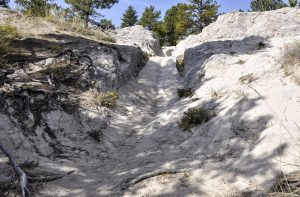 Fort Hall, Idaho by then. As time went on, the trail was cleared all the way to the Willamette Valley in Oregon. These days, the trail crosses our highways in many places, and markers have been placed so the travelers can learn a little history of the trail and what might have happened at each part of it. At the time my parents were showing us all those markers, my sisters and I usually groaned about stopping yet again, at another of the endless Oregon Trail markers that, at that time, we dreaded being forced to read all about. These days, when I think back, I can appreciate the things they tried to show us in this great nation of ours. And I can appreciate the ruts in the rocks outside of Guernsey that have endured for 184 years.
Fort Hall, Idaho by then. As time went on, the trail was cleared all the way to the Willamette Valley in Oregon. These days, the trail crosses our highways in many places, and markers have been placed so the travelers can learn a little history of the trail and what might have happened at each part of it. At the time my parents were showing us all those markers, my sisters and I usually groaned about stopping yet again, at another of the endless Oregon Trail markers that, at that time, we dreaded being forced to read all about. These days, when I think back, I can appreciate the things they tried to show us in this great nation of ours. And I can appreciate the ruts in the rocks outside of Guernsey that have endured for 184 years.
 I was listening to a book recently about shipwrecks on the Great Lakes and a thought came to my mind that really made me quite sad…though definitely not as sad as when I consider the loss of life that took place in those many wrecks. My Uncle Bill Spencer told me years ago that the Great Lakes are littered with ships that were lost in some of the worst storms on the lakes. In fact, he told me that if you fly over Lake Superior, which is the lake near where he lived most of his life, you could actually see the ships on the bottom of the lake. That thought always made me want to charter a small plane and go see for myself.
I was listening to a book recently about shipwrecks on the Great Lakes and a thought came to my mind that really made me quite sad…though definitely not as sad as when I consider the loss of life that took place in those many wrecks. My Uncle Bill Spencer told me years ago that the Great Lakes are littered with ships that were lost in some of the worst storms on the lakes. In fact, he told me that if you fly over Lake Superior, which is the lake near where he lived most of his life, you could actually see the ships on the bottom of the lake. That thought always made me want to charter a small plane and go see for myself.
Shipwrecks aside, the book told of the different reasons that ships went down, and how the safety regulations were often extremely inadequate. From not enough lifeboats, to lifejackets that were stored to far from the posts to be reached, to companies who regularly pressured their 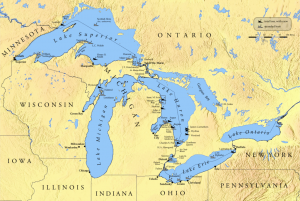 captains to take their ships out in terrible storms, the life of the sea was very dangerous. Of course, there are still shipwrecks today, although the last sinking on the Great Lakes was on November 10, 1975, when the SS Edmond Fitzgerald went down in a horrible November gale. With more recent safety regulations, the Great Lakes have been able to stave off shipwrecks in the last 45 years.
captains to take their ships out in terrible storms, the life of the sea was very dangerous. Of course, there are still shipwrecks today, although the last sinking on the Great Lakes was on November 10, 1975, when the SS Edmond Fitzgerald went down in a horrible November gale. With more recent safety regulations, the Great Lakes have been able to stave off shipwrecks in the last 45 years.
Still, it is not the number of wrecks, or even the lives lost, that has me considering a loss that is even greater…and least from the viewpoint of genealogy. As I was listening to the book, I heard that in several situations, they could not get an exact count of the lost, even if they technically knew how many were on board. The ships manifests had gone down with the ship. My mind raced. If there were people on those ships who had 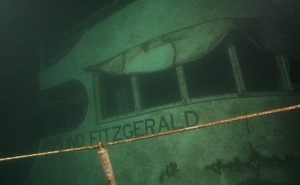 immigrated here, and their names were not recorded somewhere, they could virtually disappear and along with them, their line in the family tree they came from. I know that the many genealogy fanatics, like me, would just cringe at the thought of one of our ancestors simply vanishing. There are so many ways for a family line to get muddied. Name changes, marriages, undocumented deaths, as well as those who just left without telling anyone, are all among the lost ones, but I hadn’t considered those who meant to stay in touch, but who were never heard from, and their family back in Europe or wherever they came from, had no idea what happened. All they knew was that they were lost forever.
immigrated here, and their names were not recorded somewhere, they could virtually disappear and along with them, their line in the family tree they came from. I know that the many genealogy fanatics, like me, would just cringe at the thought of one of our ancestors simply vanishing. There are so many ways for a family line to get muddied. Name changes, marriages, undocumented deaths, as well as those who just left without telling anyone, are all among the lost ones, but I hadn’t considered those who meant to stay in touch, but who were never heard from, and their family back in Europe or wherever they came from, had no idea what happened. All they knew was that they were lost forever.
 So many of the men and women who return from combat, when many of their buddies didn’t, suffer from a multitude of feelings. Many feel like it should been them killed in the bombing, shooting, plane crash, or whatever it might have been that took their buddy or buddies, and somehow let them alive. No matter that they were quite possibly wounded too, maybe even lost a limb. The point was that somehow they had come back alive, and they carry the guilt of that with them always.
So many of the men and women who return from combat, when many of their buddies didn’t, suffer from a multitude of feelings. Many feel like it should been them killed in the bombing, shooting, plane crash, or whatever it might have been that took their buddy or buddies, and somehow let them alive. No matter that they were quite possibly wounded too, maybe even lost a limb. The point was that somehow they had come back alive, and they carry the guilt of that with them always.
Some of those returning heroes struggle with the loss of their feeling all their lives. Some of them take risks, feeling like they are living on borrowed time, and if their time comes, it will almost be a form of justice. Some feel 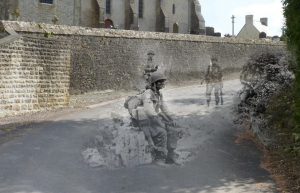 like it is borrowed time, but look at it more like living a gift. They might try to live up to what they think would make their buddies would be proud of. It doesn’t matter how they live their lives, for some, it will never be enough…in their minds anyway. They feel like their buddy died, and because of that, they can have a family…one their buddy never got to have. And if those buddies who were lost had a family, they feel an even greater burden, because not only did their buddy lose out of being with his family, but the family lost him too.
like it is borrowed time, but look at it more like living a gift. They might try to live up to what they think would make their buddies would be proud of. It doesn’t matter how they live their lives, for some, it will never be enough…in their minds anyway. They feel like their buddy died, and because of that, they can have a family…one their buddy never got to have. And if those buddies who were lost had a family, they feel an even greater burden, because not only did their buddy lose out of being with his family, but the family lost him too.
War is not an easy thing to go through, and those of us who are home, especially those of us with no one in the war, cannot really understand what  they go through either in the war, or after the war. It’s impossible. There are other kinds of survivors guilt, and I don’t suppose one is easier than the other, but it seems to me that because of the trust, companionship, and love these men feel for each other; and the idea that in the end, he couldn’t save the buddy or buddies who he felt were somehow his responsibility…well, it would be devastating. I can’t even begin to imagine. And the mind is a tough thing to get past, once it gets an idea firmly ingrained in it. For many soldiers, finally deciding that they aren’t living on borrowed time is a lifelong process, and all their family can do is pray they can make the transition back to living life again. I pray they can too.
they go through either in the war, or after the war. It’s impossible. There are other kinds of survivors guilt, and I don’t suppose one is easier than the other, but it seems to me that because of the trust, companionship, and love these men feel for each other; and the idea that in the end, he couldn’t save the buddy or buddies who he felt were somehow his responsibility…well, it would be devastating. I can’t even begin to imagine. And the mind is a tough thing to get past, once it gets an idea firmly ingrained in it. For many soldiers, finally deciding that they aren’t living on borrowed time is a lifelong process, and all their family can do is pray they can make the transition back to living life again. I pray they can too.
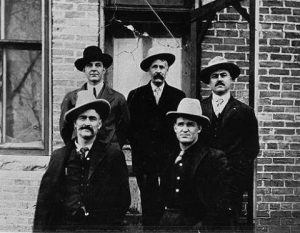 In the early years of Wyoming’s history, there was contention between cattle ranchers and sheep ranchers. The cattlemen thought the land was theirs, and they thought the sheepmen were invading their domain, and they weren’t going to allow it. Cattlemen were first to arrive in the Big Horn Basin, trailing in huge herds of cattle in 1879. They insisted their early arrival established a prior claim to the grass on the government land where their herds grazed. But the law said otherwise. The Cattle and Sheep Wars sprung from this dispute in the Western United States, but they were most common in Texas, Arizona, and the border region of Wyoming and Colorado. The cattlemen thought the sheep destroyed the public grazing lands, which they had to share on a first-come, first-served basis.
In the early years of Wyoming’s history, there was contention between cattle ranchers and sheep ranchers. The cattlemen thought the land was theirs, and they thought the sheepmen were invading their domain, and they weren’t going to allow it. Cattlemen were first to arrive in the Big Horn Basin, trailing in huge herds of cattle in 1879. They insisted their early arrival established a prior claim to the grass on the government land where their herds grazed. But the law said otherwise. The Cattle and Sheep Wars sprung from this dispute in the Western United States, but they were most common in Texas, Arizona, and the border region of Wyoming and Colorado. The cattlemen thought the sheep destroyed the public grazing lands, which they had to share on a first-come, first-served basis.
On April 2, 1909, the range war between the cattlemen and sheepmen in the Ten Sleep, Wyoming area came to a head, when a group of cattlemen decided that they were going to settle this battle once and for all. They headed to Spring Creek seven miles south of Ten Sleep, Wyoming where they knew of a camp. This was to be the last of the sheep raids in the Big Horn Basin. That fateful day, seven cattlemen attacked a sheep camp near  Spring Creek, just south of Ten Sleep, in the southern Big Horn Basin. When the raiders attacked, they killed three men, two of whom the burned to death in their sheep wagon. Then shooting the third man, the decided to kidnap two others. Then they killed the sheep dogs and dozens of sheep and destroyed thousands of dollars of personal property. It was the deadliest sheep raid in Wyoming history. I understand killing in war, but this was murder, and it was horrific!!
Spring Creek, just south of Ten Sleep, in the southern Big Horn Basin. When the raiders attacked, they killed three men, two of whom the burned to death in their sheep wagon. Then shooting the third man, the decided to kidnap two others. Then they killed the sheep dogs and dozens of sheep and destroyed thousands of dollars of personal property. It was the deadliest sheep raid in Wyoming history. I understand killing in war, but this was murder, and it was horrific!!
Wyoming was a territory from July 25, 1868 to July 10, 1890. Early on, there were more cattle ranches than sheep ranches, and the cattlemen felt like they had priority to public lands. Sheep raids began to plague Wyoming since the late 1890s, by which time sheep outnumbered cattle on Wyoming ranges. By 1909, at least six men had been killed, thousands of sheep had been slaughtered, and many thousands of dollars of property destroyed. Nevertheless, there had not been a single conviction for a crime committed during a sheep raid.
It’s really no surprise, given the rising numbers of sheep on the range in those years, that cattlemen were 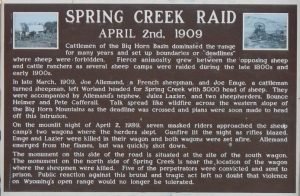 feeling pressured. By 1894 there were 1.7 million sheep in Wyoming and only 675,000 cattle. By 1909, the state’s peak year for sheep, there were more than six million sheep, and only 675,000 cattle. It makes sense that there were tensions, but that did not excuse the men on either side committing murder. Yes, Wyoming was a part of the wild west, and the lawmen were not always readily available, but that did not mean that these men should be able to kill the competition. We are ultimately, civilized people after all, even if we do live in the wild west. After the arrests for the Spring Creek Raid, the cattlemen we reluctant to raid the sheep camps, and with that, a horrific event of the old west passed into history.
feeling pressured. By 1894 there were 1.7 million sheep in Wyoming and only 675,000 cattle. By 1909, the state’s peak year for sheep, there were more than six million sheep, and only 675,000 cattle. It makes sense that there were tensions, but that did not excuse the men on either side committing murder. Yes, Wyoming was a part of the wild west, and the lawmen were not always readily available, but that did not mean that these men should be able to kill the competition. We are ultimately, civilized people after all, even if we do live in the wild west. After the arrests for the Spring Creek Raid, the cattlemen we reluctant to raid the sheep camps, and with that, a horrific event of the old west passed into history.
 Not many people these days have heard of Hedy Lamarr, but I have heard of her, because she was an actress in my parents’ era. It goes without saying that Hedy Lamarr was beautiful…by any standard. Hedy Lamarr was a star in the 1930s and 1940s, starring in some well known movies including Boom Town with Clark Gable and Samson and Delilah with Victor Mature. While she’s certainly famous because of her acting career, she didn’t make any big world changes because she starred in some old movies. Instead, Hedy Lamarr had a pastime that did change the world. You wouldn’t know it…or certainly you wouldn’t expect it…but in her spare time Hedy Lamarr liked to work on her inventions. Seriously, who would have thought that?
Not many people these days have heard of Hedy Lamarr, but I have heard of her, because she was an actress in my parents’ era. It goes without saying that Hedy Lamarr was beautiful…by any standard. Hedy Lamarr was a star in the 1930s and 1940s, starring in some well known movies including Boom Town with Clark Gable and Samson and Delilah with Victor Mature. While she’s certainly famous because of her acting career, she didn’t make any big world changes because she starred in some old movies. Instead, Hedy Lamarr had a pastime that did change the world. You wouldn’t know it…or certainly you wouldn’t expect it…but in her spare time Hedy Lamarr liked to work on her inventions. Seriously, who would have thought that?
World War II began in 1939, but after the Japanese attacked Pearl Harbor on December 7, 1941, the United States entered the war. By 1942, Lamarr was at the height of her acting career. Still, like many patriotic Americans, she wanted to help in the war effort. She could have gone in as a nurse, or something, but she had something else in mind. Hedy Lamarr wanted to help the Allies come up with a communications system that couldn’t be intercepted by enemies. Now, I can only imagine how that would have gone over in an era where woman were thought not to understand the ways of war. So she and her friend, composer George Antheil, patented an idea for something they called the “Secret Communications System.” It was a system that would change radio frequencies in a per-programmed method. I hadn’t heard of such a method, although I suppose others have. If someone was listening…and the enemy was always trying to listen, they would only hear snippets before it changed to a different frequency. It sounds logical, but ultimately, the military didn’t end up using the system.
Flash forward a few decades, and you will find that Lamarr and Antheil’s patent became really important because it was a cheap and effective way to create security in new emerging technologies like military communication, cellular phones, and WiFi. What the military couldn’t use effectively in World War II, became important part of modern-day communication, and something most of us couldn’t do without…especially in the an 
![]() middle of a global pandemic. To look at her, Hedy Lamarr would have instantly been classified as a pretty girl, but most likely with out a head for mathematics or science…especially not in the field of electronics, but that classification would have proved very wrong. Hedy Lamarr had it all…looks and brains. Her contributions to modern-day technology prove that. As for Lamarr, her film career cooled down in the 1950s and her last movie was released in 1958. She became reclusive in her later life and passed away on January 19, 2000. She was 86.
middle of a global pandemic. To look at her, Hedy Lamarr would have instantly been classified as a pretty girl, but most likely with out a head for mathematics or science…especially not in the field of electronics, but that classification would have proved very wrong. Hedy Lamarr had it all…looks and brains. Her contributions to modern-day technology prove that. As for Lamarr, her film career cooled down in the 1950s and her last movie was released in 1958. She became reclusive in her later life and passed away on January 19, 2000. She was 86.
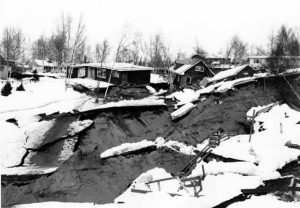
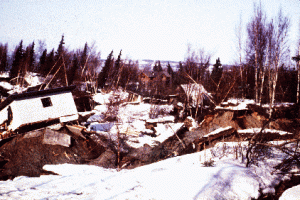 The earthquake struck at 5:35pm local time on Good Friday, March 27, 1964. Its epicenter was 12.4 miles north of Prince William Sound, 78 miles east of Anchorage and 40 miles west of Valdez. Across southcentral Alaska, ground fissures, collapsing structures, and tsunamis resulting from the earthquake caused about 131 deaths. Soil liquefaction, fissures, landslides, and other ground failures caused major structural damage in several communities and much damage to property. Anchorage was hit very hard, and sustained great destruction or damage to many inadequately earthquake-engineered houses, buildings, paved streets, sidewalks, water and sewer mains, electrical systems, and other man-made equipment, particularly in the several landslide zones along Knik Arm. Two hundred miles southwest, some areas near Kodiak were permanently raised by 30 feet. Southeast of Anchorage, areas around the head of Turnagain Arm near Girdwood and Portage dropped as much as 8 feet, requiring reconstruction and fill to raise the Seward Highway above the new high tide mark.
The earthquake struck at 5:35pm local time on Good Friday, March 27, 1964. Its epicenter was 12.4 miles north of Prince William Sound, 78 miles east of Anchorage and 40 miles west of Valdez. Across southcentral Alaska, ground fissures, collapsing structures, and tsunamis resulting from the earthquake caused about 131 deaths. Soil liquefaction, fissures, landslides, and other ground failures caused major structural damage in several communities and much damage to property. Anchorage was hit very hard, and sustained great destruction or damage to many inadequately earthquake-engineered houses, buildings, paved streets, sidewalks, water and sewer mains, electrical systems, and other man-made equipment, particularly in the several landslide zones along Knik Arm. Two hundred miles southwest, some areas near Kodiak were permanently raised by 30 feet. Southeast of Anchorage, areas around the head of Turnagain Arm near Girdwood and Portage dropped as much as 8 feet, requiring reconstruction and fill to raise the Seward Highway above the new high tide mark.
I came to know of this horrific 9.2 magnitude earthquake when my husband, Bob and I were on a cruise to Alaska. The cruise ended in Anchorage, and we had taken an extra day for exploration of the area. My first notice of this Alaskan earthquake was on a shuttle ride from the airport to Anchorage proper. We had the day before our flight at 10:30pm, so we stored our luggage at the airport and took the shuttle back into town. The shuttle driver took us by the Turnagain Heights neighborhood, the current location of Earthquake Park. She told us that the soil there had liquified and homes were swallowed…some almost completely, leaving only their chimneys above ground, while others were swept out to sea in the ensuing tsunami waves. I couldn’t shake the dreadful feeling of the horror that had happened there. A stop in a museum, including a documentary about the 1964 Alaskan earthquake, told me that the earthquake that happened in the modern-day Earthquake Park, was the 1964 Alaskan earthquake. Of course, I was only 8 years old when it happened, so I guess that it is not so odd that I hadn’t heard of it.
We began a much longer than expected walk along the Tony Knowles Coastal Bicycle Trail. Of course, people were walking on the trail too, but we had no idea how long the walk back to the airport would be. Nevertheless, the walk took us through Earthquake Park, and…well, I have only noticed such an air of heaviness in one other place…Gettysburg Battlefield. There is something about being in a place where so much death and destruction occurred. I takes on an air of being “hallowed ground” somehow. President Lincoln knew what he was talking about when he gave the Gettysburg Address. Walking through Earthquake Park, you could see the rippled ground, where the liquified soil had rolled back and forth during the earthquake. We didn’t get off the trail, so if there were chimneys visible near us, we didn’t see them, but I was moved to think that beneath our feet, there might be houses that people had lived in. I didn’t know if the people who had lived there were there still, or if 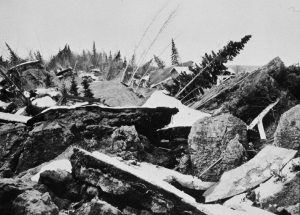
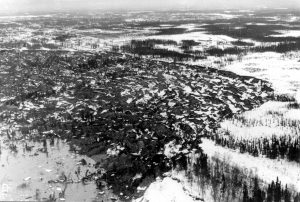 they had been located and buried after the disaster. Whatever the case may be, I left the area feeling very different than I had just two days earlier. I had been in the exact place where such a devastating disaster had happened, and I have never forgotten that place, just as I have never forgotten the feeling I felt at Gettysburg. Some things just have a profound effect on us…forever.
they had been located and buried after the disaster. Whatever the case may be, I left the area feeling very different than I had just two days earlier. I had been in the exact place where such a devastating disaster had happened, and I have never forgotten that place, just as I have never forgotten the feeling I felt at Gettysburg. Some things just have a profound effect on us…forever.

